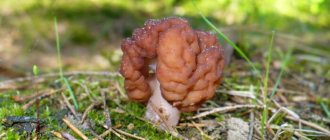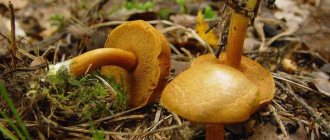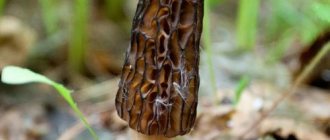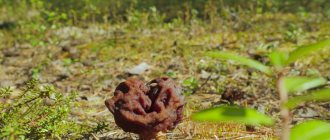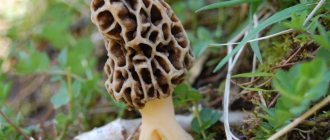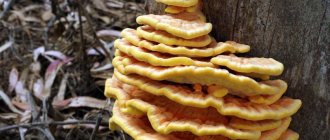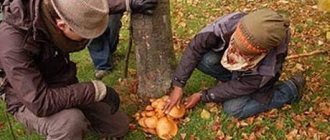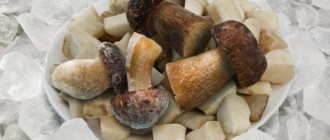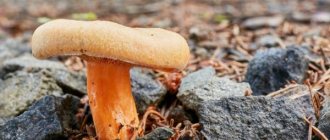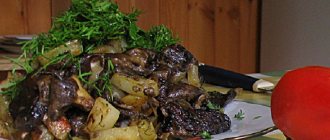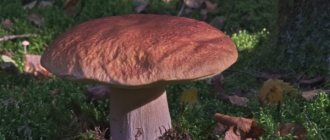Autumn stitch mushroom (Gyromitra infula) – description and photo. Is autumn stitch edible or not? Preparing autumn stitching: how to do it; does it make sense to use this mushroom?
Hello dear reader!
We collect string mushrooms early in the spring. They appear in the forest soon after the snow melts, for which they are called “snowdrop mushrooms.”
But there is at least one line that grows not in spring, but in autumn. This is the autumn stitch (Gyromitra infula). The mushroom is also classified as a member of the Discinaceae family.
Description of the mushroom
Autumn stitch belongs to the genus of stitches of the Discine family.
Its Latin name is Gyromitra infula or Helvella infula. Among the people it has quite a lot of synonyms, among them:
- autumn lobe or infula-like;
- gyromytra inviolable;
- Helvella infula or infula-like;
- horned line;
- smarzhok.
The width of the cap can reach 10 cm, its shape is irregular, saddle-shaped, two, three or four lobed. The edge is turned up, attached to the leg. The apothecia apex is red-brown, dark, often wrinkled, less often smooth. The ends are paler, the surface is velvety.
There is no hymenophore, the lower part of the cap is smooth and light. The autumn line refers to marsupial fungi. The spores are white, elliptical, and the paraphyses are cylindrical and club-shaped.
The pulp is thin, translucent, resembles cartilage or wax, whitish. There is no smell, it is similar to the pulp of similar species.
The leg grows up to 6 cm in height and up to 2.5 cm in diameter. Usually flattened on the sides, hollow inside. It can take on shades from white to grayish-brown. Its shape is cylindrical, thickened at the bottom.
A little history
Jacob Christian Gottlieb Schaeffer, a German botanist and mycologist, first wrote about this mushroom. Later, in 1886, Lucien Quele, the founder of the French Mycological Society, changed the genus to which the autumn line belongs.
Features of the view
- According to some data, it is generally accepted that the variety of fruiting bodies is contraindicated for consumption. If we consider these mushrooms taking into account their taste, they are assigned to the fourth category. If pre-processing and final thermal preparation are carried out in violation of the rules, a person runs the risk of poisoning.
- Now let us briefly describe the external features by which this representative of the family can be distinguished from all the others. Its top is velvety in structure, irregular in shape, and color ranges from brown to brownish. It occurs in a fold, smoothed or growing to the base.
- In the listed specimens, the leg is pigmented in the same tone as the apex. But in some cases, a bluish tint may be observed, as well as the presence of lint. The shape of the base is comparable to an elongated cylinder. The pulp breaks quickly due to its fragility, so after harvesting it is advisable to handle the harvest with care.
- In mushrooms of this variety, the pulp does not emit any odor. As for the nature of their growth, mushrooms prefer to settle alone, but large colonies can also be found. It is better to do collecting from mid-summer until late autumn. Mushrooms are not suitable for consumption raw; they are edible conditionally.
- The variety of fruiting bodies under discussion is classified as a lobed genus. Mushrooms are considered the most popular. They received the title “autumn” due to the fact that gathering must be done from mid-late summer to autumn (in some southern regions even late). Accordingly, these mushrooms differ from their spring relatives, which come to the surface in the spring. Also, the differences lie in the fact that autumn representatives have much more toxic substances in their composition.
Read also: How to pickle milk mushrooms - Pickling, Recipes, tips, descriptions, reviews
False doubles
The autumn lobe is a typical representative of its genus. Externally, it is quite similar to many of them, especially those that repeat the shade of the cap.
| Name | Fruiting body | Controversy | Danger |
| Smarzhok | Brown with a red tint | White | Poisonous |
| Line | Smaller, with a purple tint | Spores are larger, white | Poisonous |
| Common lobeweed | Outwardly it resembles a brain, in young specimens it is smooth, then becomes wrinkled. Has a fruity aroma | Pale yellow, oily | Edible |
| The line is gigantic | The largest mushroom of its kind, reaches 30 cm in diameter, the cap is yellow and ocher. | Light ocher spores | Conditionally edible |
Another important difference is the time of fruiting; most lines grow in spring or summer, and therefore it is not difficult to distinguish them from autumn ones.
Spreading
- Fruiting bodies are more common in Eurasia and North America. Most often, such mushrooms are found in damp pine and mixed forests. In addition, specimens grow well in cleared areas and near roads.
- These fruits can be found singly or grow in small groups. Most often this happens on rotting and dead trees. Mushrooms are also found near such places. Starting from mid-summer, single specimens can already be found. Closer to the beginning of autumn, active fruiting of the lines begins.
Medicinal properties and use in medicine
The most important feature of the line is the presence of an analgesic effect. The most commonly used tincture is alcohol to relieve pain in the joints. It is believed that cartilage tissue can even be restored.
To prepare the tincture you will need the inviolable gyromitras themselves and ordinary vodka:
- Wash the mushrooms and cut into small pieces.
- Place in a glass jar, compacting tightly.
- Pour vodka to the very top so that all the fruits are covered with liquid.
- Cover with a lid and store in a dark, cool place for 15 days.
- Shake the mixture in the jar daily.
- After two weeks, strain, leave only the tincture for treatment, and discard the fruits.
This drink will be useful for arthrosis, osteochondrosis, rheumatism, polyarthritis, lupus erythematosus or radiculitis.
Attention! You should not use mushroom tinctures without consulting your doctor.
Traditional medicine treats cough, bronchitis and pneumonia (rubbing) with this remedy. It is used for neuralgia and to eliminate formed adhesions after surgery.
It is strictly forbidden to eat autumn stitches for children under 12 years of age, pregnant and lactating women, or in case of individual intolerance. This applies even to carefully prepared and processed fruits. Weakened immunity, as well as the presence of chronic diseases of internal organs are contraindications for consumption.
In addition, the presence of heart ailments, stomach pathologies, ulcers and gastritis is a reason to refuse autumn lobe. Traditional medicine says that prolonged use of tincture from these fruits can affect the functioning of the cardiovascular system.
Mushroom "Inoltra"
Stitches - help for sore joints
This is an amazingly healing mushroom. A forester friend once told me that for a long time he wondered why moose often come to forest fires in the spring, and then he realized that these fires are favorite places for grazing, and moose come precisely for them - but not to feed themselves and get their vitamins, namely, to heal. By the way, what’s surprising is that moose, this forester claims, are great connoisseurs of herbs and mushrooms: in May they eat strings, in July - chanterelles, and in September - fly agaric, but in winter moose try to gnaw... chaga. This is their mushroom preference.
During the winter, moose joints “get tired” - they wear out, and in the lines, biochemists found a substance - gyromitrin, which is akin to modern analgesics - gyromitrin anesthetizes. And the latest discovery by American scientists in strings and morels is the ST-4 polysaccharide, similar to the substance chondroitin, obtained from the joints of ungulates. That is, in addition to pain relief, the stitches also... restore the cartilage tissue of the joint!
In the villages they used to know this feature of the lines and made tinctures from them specifically for the treatment of joint diseases. Indeed, the line was well known to the healers and witches of Ancient Rus'. There is an ancient recipe that came down on wooden tablets found during excavations in Staraya Ladoga (one of the most ancient cities of Ancient Rus'). There it was recommended to collect “...the lips (mushrooms) of wrinkled kaki begin to grow immediately after the snow and all the herbs are blooming, as they grow nearby - dry them and make potions against aching bones...”.
They collect an ordinary stitch - exactly the same stitch that perfectly helps with joint diseases - any arthrosis: radiculitis, rheumatism, polyarthritis, osteochondrosis, lupus erythematosus (by the way, also a type of arthrosis).
To correct arthrosis, a mushroom preparation called Stitches in capsules has been developed.
Source of information - materials from the company Center for Fungotherapy Irina Filippova
Evaluation of taste qualities, preparation and initial preparation of the line
Vishnevsky considers the autumn line to be edible, but only if it is first boiled and dried. Many classify it as a conditionally edible mushroom of the fourth category, but in its raw form it contains too much poison. The line can cause severe poisoning. Older fruits are more toxic. Frequent use is dangerous, as toxins can accumulate in the human body.
The mushroom is not recommended for consumption, since its properties have been studied too poorly; despite all the preparations, the amount of poison can be very dangerous. Scientists have determined that smarzhok contains gyrometrin and methylhydrazine, which cause not only poisoning, but also death. In addition, gyrometrin is not removed by digestion, for this reason it is believed that the mushroom can only be consumed after drying.
Interesting! Despite all the fears of scientists, no deaths from the use of autumn line have been recorded. Perhaps due to the fact that it is rarely collected by lovers of quiet hunting, because at this time there are many tasty and quite edible mushrooms in the forest.
If you nevertheless decide to try autumn stitches for food, then first you should clean them of forest debris and insects, slugs, which often hide under the top part. The stems are usually removed, leaving only the caps.
Important! For cooking, it is better to use the youngest specimens, they contain the least toxic substances.
Before cooking, it is better to boil the lines twice for 20 minutes, changing the water. Then you can fry, cook soup, stew. In order to dry mushrooms, they should not be washed, just peeled, strung on a thread and hung in the sun, in the warmest and most well-ventilated place. Store dry fruits in a closed container, away from strong odors.
To prepare autumn paddles in sour cream, you will need:
- mushrooms – 600 g;
- sour cream – 6 tbsp. l.;
- hard cheese – 200 g;
- onions – 300 g;
- butter – 100 g;
- salt and pepper to taste.
Cooking process:
- Pre-clean the mushrooms and boil twice for 30 minutes, changing the water.
- Heat the oil in a frying pan, add finely chopped onion and buttermilk to it, cook until the lines become soft.
- 5 minutes before it’s ready, add salt and pepper, add sour cream, boil the mixture and remove from the stove.
When serving these paddles, you need to sprinkle them with grated cheese, then the taste will become even richer and more pleasant.
Video gallery
How to prepare autumn stitch?
The collected autumn lines should be boiled. Out of caution, it is better to do this twice for 15–20 minutes, draining the broth. After which the mushrooms are fried. There are no other ways to use autumn stitch.
So it's simple. But is it worth doing this?
Firstly, the autumn line is not such a numerous mushroom. I came across no more than 3–4 fruiting bodies at a time.
Secondly, this mushroom does not have any special taste. With the lines growing in the spring, everything is more or less clear. In spring, many people want fresh mushrooms. But in the fall you can find better mushrooms!
In the fall, I prefer to collect purple row or at least gray row. There are a lot of them growing, and these mushrooms are much tastier than autumn mushrooms.
Best regards, Alexander Silivanov
Ordinary
Here's what's remarkable about the common string mushroom:
the cap is wrinkled brown (various shades, becomes lighter with age), the edges at the bottom are fused with the stem (a kind of hollow sac is formed), diameter 2-10 cm; the leg is asymmetrical, wrinkled, partially buried in the soil, thickened closer to the base, up to three centimeters long, light, sometimes pink; the pulp is white, thin, waxy, brittle, with a faint mushroom odor, and has no special taste; grows in groups and singly, found in all forest zones of Russia, with the exception of the Far North; collected from the end of March until about mid-June (depending on the climate zone), mushrooms appear like snowdrops immediately after the snow melts; classified as medicinal, in the post-Soviet space it is eaten with caution, in some countries it is considered a delicacy; distributed in Europe, CIS countries, North America.
Where do morels grow in 2022?
In search of morels, you can go both to the forest zone and to open areas where birch and aspen trees grow, there are swamps, and there is coniferous litter that retains the moisture necessary for the active fruiting of the mycelium.
In the deciduous forest
In the central zone and central part of Russia, mushrooms are most often found in main forest belts, meadows and open areas with sandy soil.
The conical morel can only be found in coniferous forests, less often near oak groves. Mushrooms germinate both in old plantings and in young plants planted no later than 10 years ago. It is better to collect after rain or snow melting so that the soil does not have time to dry out.
The giant morel is more unpretentious to the area of germination and is more often found than others in the most unusual places: planting poplar and other deciduous trees, field plots and meadows where no human has set foot for a long time.
When choosing a favorable day for quiet hunting from April to May, you should focus on the following factors:
1) Humidity. Mushrooms germinate only in damp weather; with the onset of heat, fruiting stops.
2) Fruiting time lasts from late March to early June. The timing may vary by several weeks, depending on the region of germination.
3) Fruiting does not exceed four weeks.
4) You can find a harvest in the deciduous and coniferous zones. To increase your luck, it is better to choose mixed forest belts.
Morels and strings do not bear fruit for long. Active germination begins with the onset of above-zero temperatures, as soon as the snow begins to melt. Growth stops with the sudden arrival of a hot climate, which is not typical for the natural habitat of spring mushrooms.
Morels can only be discovered in the spring. However, high productivity allows for a good harvest for a long time. Many cooks freeze the fruits in the freezer after heat treatment, gradually using them as an ingredient for preparing mushroom dishes.
Many mushroom pickers are afraid to collect morels because of their unusual appearance. And only gourmets who know a lot about the taste and aroma of the delicacy go out every year in search of edible prey. It is not for nothing that in many countries the usefulness and taste of mushroom products are compared with boletus, chanterelles and champignons.
Video of collecting morels (morel caps):
Poisonous varieties
The most toxic and poisonous mushrooms in the marsupial family are:
No. 1 - Ordinary stitch
The harm from using an ordinary stitch has been scientifically proven. Its pulp contains the poison gyromitrin, which persists even after heat treatment. Regardless of the number of boils and drains of water, toxins do not decompose and can cause irreparable harm to the human body.
And if in conditionally edible lines, gyromitrin is destroyed when dried at high temperatures. Contents in large volumes in an ordinary line do not allow the harm to be reduced even to a minimum.
Statistics of poisonings and deaths are more common in Germany than in Russia, Belarus and Ukraine. However, cases of intoxication are still registered. Therefore, doctors prohibit consuming fruit pulp even in small quantities.
No. 2 – Autumn stitch
The autumn variety is also included in the list of conditionally edible ones. The third category is characterized by a minimal content of toxins that decompose after drying. Boiling for further preparation is not recommended at all. Gyromitrin does not decompose after boiling even after repeated boiling. The high temperature used during drying can only destroy small amounts of poison. The use of this method with poisonous mushrooms is inappropriate.
The look of the fall stitching is classic. The cap is large, externally similar to the kernel of a walnut. It is colored red, less often yellowish-gray. The leg is not large, flat and wide, hidden behind the upper part of the fruit.
After drying, the line can be used within 90-120 days. Only during this period do toxins completely decompose.
Similar species
- The fruiting bodies in question have enough external similarities with the Red Book and dubious line. Such mushrooms are extremely rare and often live exclusively in subalpine and subarctic landscapes.
- At the same time, similar specimens are smaller in size. The fruiting bodies have brownish-purple tones and fairly large spores.
- In addition, such mushrooms begin to bear fruit only in mid-autumn. Therefore, it is difficult to confuse the copy in question with such a line. This mushroom is poisonous and is not used for industrial purposes.
Virulence
In the modern world, new research has confirmed that it is better not to collect such mushrooms, much less eat them. When hunting quietly, it is better to choose other fruiting bodies that you can easily prepare and enjoy with peace of mind. There is no need to risk your own health.
Where are the lines growing in 2022?
Fruiting sites are identical to morels. Before you go in search of a mushroom that has a large number of poisonous subspecies, you should think repeatedly whether collecting it is worth the risk of harm to your health and the condition of your loved ones. It is better to prefer edible morels or wait for the mushrooms, which germinate a little later.
It is not difficult to detect the lines; most often they sprout in the vicinity of coniferous trees or deciduous forest belts. Found near aspen and birch trees, swampy areas.
Benefit
There is such a term - fungotherapy, or mushroom treatment. In practice, it is not used very often, but recently this area of traditional medicine has been developing rapidly. Stitch mushrooms have a number of beneficial properties due to the presence of various chemical compounds in them:
- increase appetite;
- “work” as a pain reliever;
- tone;
- help with neuralgia;
- used in the treatment of glaucoma, myopia, cataracts, farsightedness;
- improve digestion;
- stimulate the pancreas.
The analgesic properties of stitches were used in ancient times for toothache, joint and muscle pain. A rubbing tincture prepared from them is used for various diseases of the musculoskeletal system, radiculitis, arthritis, and osteochondrosis. Tissue inflammation is relieved, and their regeneration occurs faster. For inflammation of the respiratory tract, use a tincture to rub the chest. Use internally only as prescribed by a doctor in a strictly defined dosage.
Preparation of alcohol tincture:
- the stitches are dried and crushed;
- 2.5 tablespoons of raw material are poured into 500 ml of vodka;
- The container with the liquid is carefully closed and stored in the refrigerator for two weeks.
The unstrained tincture is ready for external use. After rubbing, it is recommended to wrap the treated area with a woolen cloth. The procedure is repeated until pain disappears or recovery occurs.
